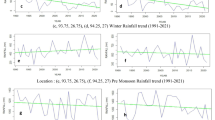Abstract
Appraisal of spatial distribution of vegetation types is an important aspect for wildlife habitat suitability and ecological studies. Remote sensing provides quick, accurate and cost and time effective methods for vegetation cover mapping. In the present study Landsat MSS data was digitally classified into various land use/forest type classes. Forested land was about 52 per cent of the study area. Four forest types, namelyAnogeissus pendula, Boswellia serra ta, mixedAnogeissus-Butea and mixed Acacia-Zizyphus occupied 28.47 percent, 6.60 percent, 18.60 percent and 9.70 percent of the forested land, respectively. The area under National Park was 51.28 percent of total study area. About 61 percent of the Park area was under tree-covered vegetation. Overall accuracies for classified and smoothened-classified images were 89.37 percent and 91.96 percent, respectively. The vegetation of the area is controlled by topography and edaphic factors.
Similar content being viewed by others
References
Champion H G and Seth S K 1968.A Revised Survey of Forest Types of India. New Delhi: Govt. of India.
Jenson J R 1936.Introduction to digital [mage Processing: A Remote Sensing prospective. Prentice Hall, New York.
Kamat D S 1986. An integrated approach to remote sensing studies for Wildlife Habitat evaluation. In. (D.S. Kamat and H.S. Panwar eds.).Proc. of the Seminar-cum-Workshop on Wildlife Habitat Evaluation Using Remote Sensing Techniques. IIRS and WII, Dehra Dun, 165–182.
Kushwaha S P S and Madhavan Unni NV 1986. Application of remote sensing techniques in forest cover monitoring and habitat evaluation—a case study at Kajiranga National Park, Assam. In (D.S. Kamat and H.S. Panwar eds.).Proc. Seminar-cum-Workshop on Wildlife Habitat Evaluation Using Remote Sensing Techniques. IIRS and WII, Dehra Dun, 238–247.
Muller Dombois D and Ellenberg H 1984.Aims and methods of Vegetation Ecology. John Wiley and Sons, New York.
Mosby H S 1971. Reconnaissance mapping and map use in Wildlife Management Techniques. (R.H. Giles Jr., ed.). The Wildlife Society, Washington, D.C., 119–136.
Parihar J S, Panigrahi S and Lahan P 1986. Remote sensing based habitat assessment of Kaziranga National Park. In. (D.S. Kamat and H.S. Panwar eds.). Proc. of the Seminar-cum-Workshop on Wildlife Habitat Evaluation Using Remote Sensing Techniques, 157–164.
Puri G S 1982.Forest Ecology. Oxford Publishing Co., New Delhi.
Rodgers W A 1985. The vegetation of Sariska Tiger Reserve. (Unpublished report). Wildlife Institute of India, Dehra Dun.
Sawarkar V B 1986. Wildlife Habitat Evaluation : Ecological Perspective and Study Techniques. In (D.S. Kamat and H.S. Panwar eds.)Proe. Seminar-cum-Workshop on Wildlife Habitat Evaluation Using Remote Sensing Techniques, 13–30.
Tiwari A K 1866. Vegetation cover and biomass assessment in proposed Rajaji National Park through remote sensing and field sampling. In. (D.S. Kamat and H.S. Panwar eds.).Proc. Seminar-cum-Workshop on Wildlife Habitat Evaluation Using Remote Sensing Techniques. IIRS and WII, Dehra Dun, 23–2128.
Tiwari A K and Kudrat M 1988. Analysis of vegetation in Rajaji National Park using IRS data.National Seminar on IRS-1A Mission and its Application Potential, Hyderabad. Dec. 21–22. (Unpublished).
Author information
Authors and Affiliations
About this article
Cite this article
Tiwari, A.K., Kudrat, M. & Bhan, S.K. Vegetation cover classification in Sariska National Park and surroundings. J Ind Soc Remote Sens 18, 43–51 (1990). https://doi.org/10.1007/BF03030732
Issue Date:
DOI: https://doi.org/10.1007/BF03030732




